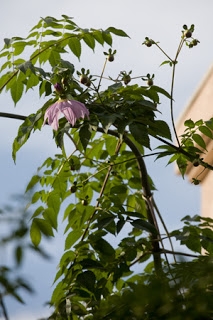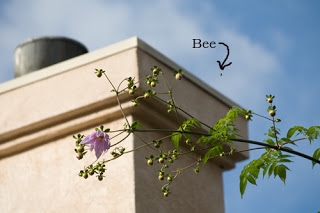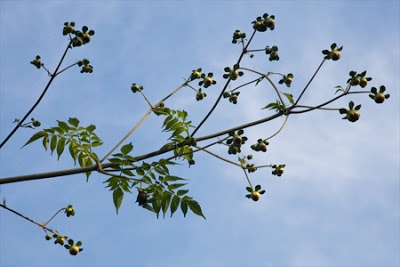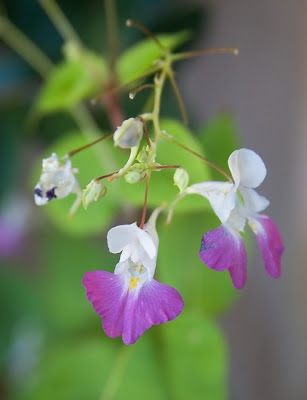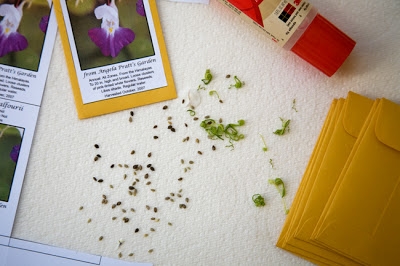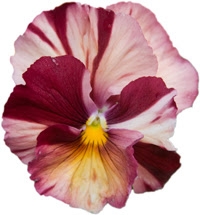
kdjflksdjfllljljjjsdfljldkjflksdjflskdjflskdjflskdjflskdjflskdjflskdjflskdjflskdjflskdjflskdjflskdjflskdjflksdjflskdjflskdjflksdjf
Tree dahlia is blooming!
On my way back from the mailbox, I looked up in the sky and was startled to see that the first of my tree dahlia buds have opened! Alert the media!
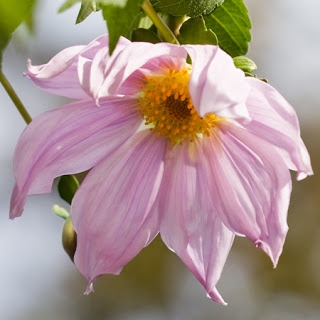
Good thing I have a telephoto lens…
I feel like I can breathe now and won’t be devastated by our first frost… ’cause I got to see these pale pink exotic beauties bloom for the second year in a row. Last year was dicier and a much closer call. They’d barely opened when we got hit with a frost that browned the foliage and scorched the petals.
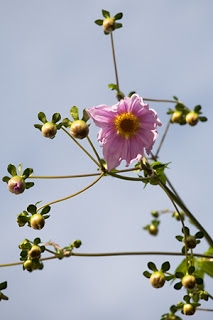
Still can’t believe it’s a dahlia
Giving thanks for warm Novembers… yet hoping it’s not due to global warming.
Sustainable Landscaping in Sacramento
 I had an opportunity to tour several sustainable landscapes in Sacramento last Friday with Dave Roberts, a local landscape contractor specializing in sustainable landscaping. Accompanying us was front yard garden advocate Sue Jennings of Sustainable Urban Gardens. After a yummy lunch at La Bou (thanks, Dave), Dave whisked us over to several of his clients’ homes in Land Park and East Sacramento that have been re-landscaped by his company, Roberts Landscape. I’m a proponent of sustainable landscaping and told Dave I’d love to see some of his gardens up close. He graciously obliged even though he’s obviously a very, very busy guy!
I had an opportunity to tour several sustainable landscapes in Sacramento last Friday with Dave Roberts, a local landscape contractor specializing in sustainable landscaping. Accompanying us was front yard garden advocate Sue Jennings of Sustainable Urban Gardens. After a yummy lunch at La Bou (thanks, Dave), Dave whisked us over to several of his clients’ homes in Land Park and East Sacramento that have been re-landscaped by his company, Roberts Landscape. I’m a proponent of sustainable landscaping and told Dave I’d love to see some of his gardens up close. He graciously obliged even though he’s obviously a very, very busy guy!
Another term that’s been coined for sustainable landscaping in Sacramento, AKA River City, is “River-Friendly landscaping”.
What does “sustainable” or “River-Friendly” landscaping mean exactly? It can mean extra attention has been paid to selecting native, drought-tolerant or wildlife-attracting plants. It can also mean efforts have been made to reduce runoff from gardens into local waterways, or that soil health is preserved and that unnecessary use of pesticides is avoided. It may also mean the ubiquitous front lawn has been reduced or replaced, and that water-guzzling foundation shrubs have been replaced with River-Friendly plants.
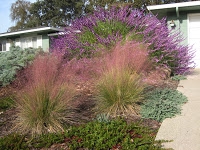

Pink Muhly, Mexican bush sage, lantana, manzanita, etc.
As outlined by the River-Friendly Landscape Guidelines handbook, here are the main principles of a River-Friendly garden:
1. Landscape Locally
2. Landscape for Less to the Landfill
3. Nurture the Soil
4. Conserve Water
5. Conserve Energy
6. Protect Water & Air Quality
7. Create & Protect Wildlife Habitat
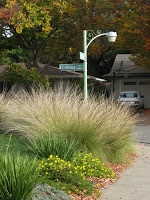

Deer Grass (Muhlenbergia rigens)
I really admire the fact that contractors like Dave and neighborhood advocates like Sue are working tirelessly to educate the public about the need for River-Friendly landscapes in the Sacramento region. Our dry summers, history of droughts lasting well into the “rainy season”, and prevalence of runoff-sensitive creeks, lakes and rivers signal that it’s time to embrace this new style of landscaping.
It’s been time to embrace our Mediterranean climate, especially since Assembly Bill 2572 was signed into law by Governor Arnold Schwarzenegger. The Bill gave us mandatory water meters and fees “based on the actual volume of deliveries, as measured by a water meter”. You’ll see that River-Friendly garden owners are watering less, but you’ll also see the abundance of butterflies, bees and hummingbirds in their yards. And, hello… flowers!
Gardens can look lush without a lawn. Houses without front lawns can please the neighbors, as evidenced by the fact that several neighbors went River-Friendly after the first Robert’s Landscape garden went in. From a gardener’s perspective, it’s just great to see something other than flat green rectangular lawns (yawn) set against the same old boxy hedges (yawn).
Whether you like a serene and formal mass of ground-hugging foliage plants… or an informal riot of color, an ever-expanding palette of River-Friendly plants provides exciting options for creating a garden that is both sustainable and aesthetically appealing.
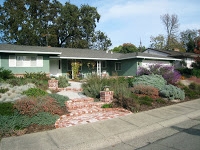 [Landscape design (on left) by Luciole Design Inc.]
[Landscape design (on left) by Luciole Design Inc.]
If you want to learn more about River-Friendly landscaping, Dave Roberts will be giving a seminar at the Northern California Home & Landscape Expo at CalExpo on Saturday, January 26. You will also be able to see a River-Friendly demonstration garden at the expo.
Seminar: River-Friendly Landscaping
A Holistic Approach to Your Yard
Dave Roberts, River-Friendly EcoLandscape Group
Date: Saturday, January 26
Time: 5:00 p.m.
Location: Pavilion Building
When you’re ready to make the switch to a River-Friendly garden, read the handbook online , visit the SacGardens.org website, or order a hard copy of the handbook. The handbook is chock full of recommendations and resources, including Roberts Landscape. Your garden could look like one of the beautiful, River-Friendly gardens pictured above!
Spotted: Front yard rock people in East Sacramento
Now you see ’em…
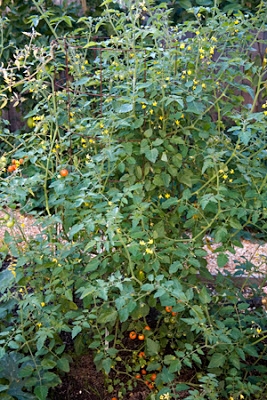
‘Sungold’ tomatoes in November
… soon you won’t. As November weather goes, this has been a warm one. In fact, I haven’t even pulled some of my summer veggies yet. See my ‘Sungold’ tomatoes? They’re still tasty and going strong, even though I’ve switched to cool-season crops and frost will come. Soon, I must remind myself.
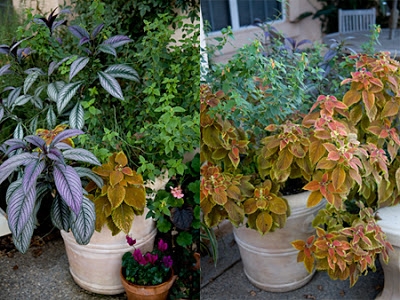
Persian shield, coleus, cuphea, cyclamen, etc.
I planted the same plants in these front porch pots, but varying sun exposure favored the tropical looking Persian shield on the left and coleus on the right. I love both heat lovers and am happy to have memorial photos because soon they will be nothing but a mushy memory.
My tree dahlias– which I’m renaming two-story dahlias because they’re 20 feet tall– have a chance to bloom if these warm temps continue!
The garden is pretty much taking care of itself right now. It has to because I’m busy with Thanksgiving plans and other stuff.
Impatiens balfourii seed collecting
The last of my Impatiens balfourii plants, commonly called Poor Man’s Orchid, are going to seed. This somewhat obscure Himalayan annual has seed pods that, when ripe, explode when touched. That makes for some pretty challenging and often comical seed collecting.
My friend Weeder gave me seeds a few years ago and because I. balfourii is a reliable reseeder, I haven’t had to replant. Her mom planted seed many, many years ago on the family ranch in Carmichael and Weeder has cultivated them– or they’ve cultivated themselves– since taking over the property after her folks were gone. Since she took over the property, not the seeds. Now that she’s in the process of selling the place to a developer, we’re both collecting seed to save and share around.
I’ve gotten pretty good at catching seeds in my left hand while gently pinching a pod with my right hand at the point where the pod connects to the stem. That seems to be the trigger point. Weeder reported that she caught a fair number of seeds recently… in her hair. The rest made it into a paper bag.
I’m playing around with making custom seed packets using coin envelopes (Office Max, Office Depot, etc.) and printing my own labels.
I wondered if it would be easy to find I. balfourii seeds online and it’s not! Select Seeds doesn’t have them. Annie’s Annuals sells the plant, but not at this time. Thompson & Morgan? Nope. Johnny’s? Nope. J.L. Hudson? Nope. Hortus Botanicus? YES! I shouldn’t be surprised. This super coolest of nurseries in Fort Bragg, CA has lots of amazing plants.
On Dave’s Garden, two DG members want it and one has it for trade. I’d be interested in knowing if other garden bloggers are growing it and where they obtained seed. Did you buy it? Was it passed along by a friend or family member?
I suppose Poor Man’s Orchid could become invasive under the right circumstances, but unless you have nothing but shade and moist soil, it should remain a well-contained and welcome rarity. The plants are easy to pull but are so pretty that you won’t want to.

